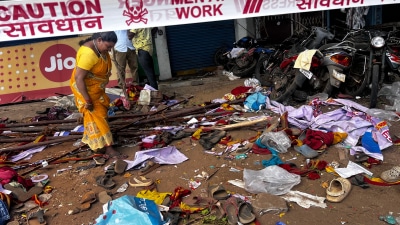Pant unimpressed by Naidu, and says so
When Andhra Pradesh Chief Minister Chandrababu Naidu went to Yojana Bhawan on Wednesday to meet Planning Commission deputy chairman K. C. Pa...

When Andhra Pradesh Chief Minister Chandrababu Naidu went to Yojana Bhawan on Wednesday to meet Planning Commission deputy chairman K. C. Pant to seek more funds in the Tenth Plan for his State, he was completely taken by surprise with the dressing down he got.
Pant, in his opening remarks during the meeting for finalisation of the Tenth Plan rapped Naidu for failures of the State in some of its key performance indicators which had been drowned in the high pitched IT achievements of the State.
Pant said that the ‘‘effects of increased FDI, privatisation and other reforms are yet to reflect in the composition of the Gross State Domestic Product (GSDP)”.
Pant chose to take a dig at the State’s IT hype. At his sarcastic best, Pant said that while ‘‘the achievements of Andhra Pradesh in the field of information technology and its use in day to day governance are widely acknowledged,’’ the State’s literacy rates at 61.11 per cent is less than the national average of 65.38 per cent. This he said, ‘‘did not go well with the IT image of the State.’’
Outlining some more hard truths in the State’s literacy performance, Pant said that the 20 percentage points gender gap in the literacy rates — with male literacy rate at 71.85 per cent against a female literacy rate at 51.17 per cent—did not augur well for a State planning rapid development. He also highlighted that the drop out rate in students between class VI and class VIII was as high as 66.5 per cent.
Pant called it a ‘‘matter of serious concern that a forward-looking state like Andhra Pradesh,’’ was making a negative contribution of funds meant for its own expenditure. The financing pattern for the State was to the tune of 48 per cent from central assistance and 59 per cent from borrowings by the State.
Pant pulled up Naidu even in the field of reforms in the power sector. He said that despite being among the few States which had unbudled the Andhra Pradesh State Electricity Board (APSEB) by forming four distribution companies and despite two tariff orders from the State Regulatory Commission, the State is still able to charge only 65 per cent of the actual cost of power supply per unit. As a result the net commercial losses of the APSEB in 2001-02 therefore stood at Rs 2,429.45 crore.
Pant pointed out that even now most agriculture users are not metred and the tariff for these users was only 31 paise per unit.
Pant while acknowledging the States achievements in bringing down poverty said that there were still pockets of high poverty in the State. He said that intra-state disparities in income levels were sharp and despite this, the State had not set up District Planning Committees (DPCs) which most other States have constituted.
Pant also said that while on the agricultural front the State had made laudable achievements, it ‘‘had a tendency to take up more irrigation projects than are warranted by available resources.’’






- 01
- 02
- 03
- 04
- 05

























